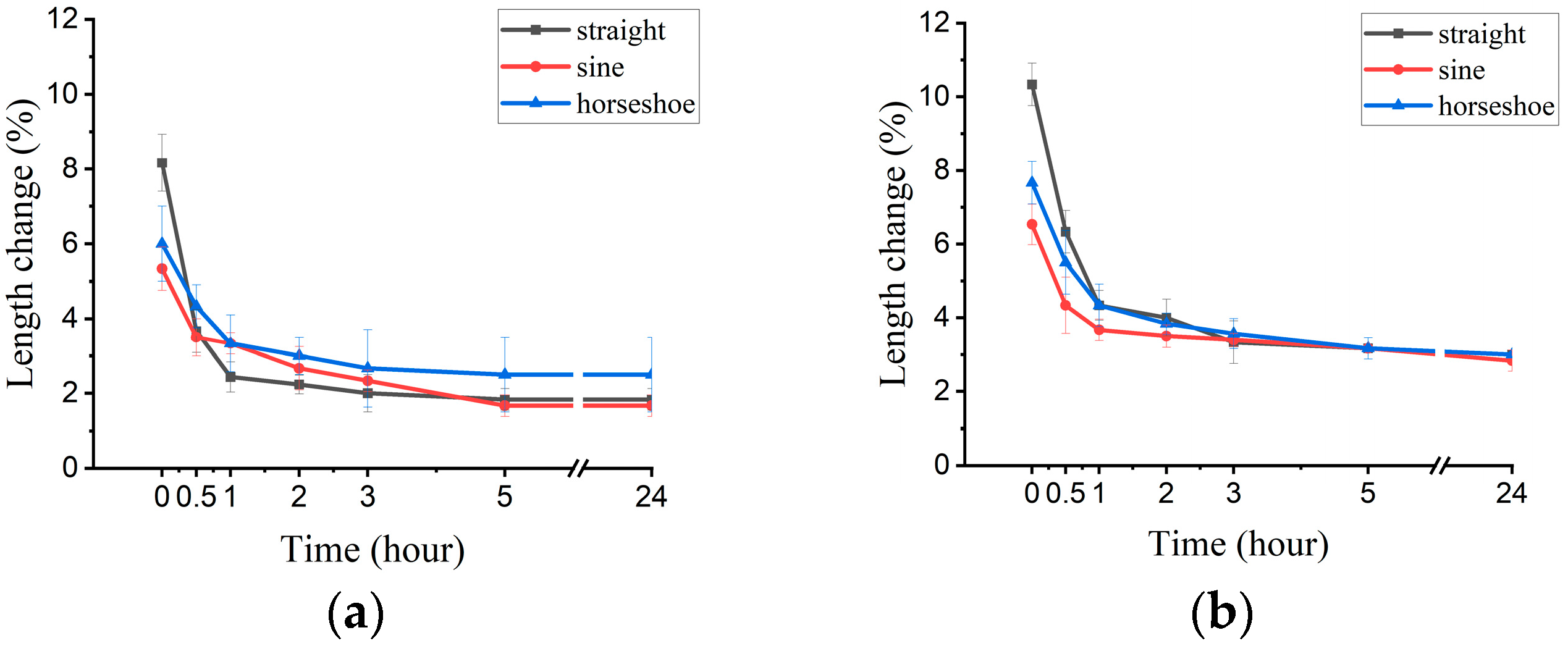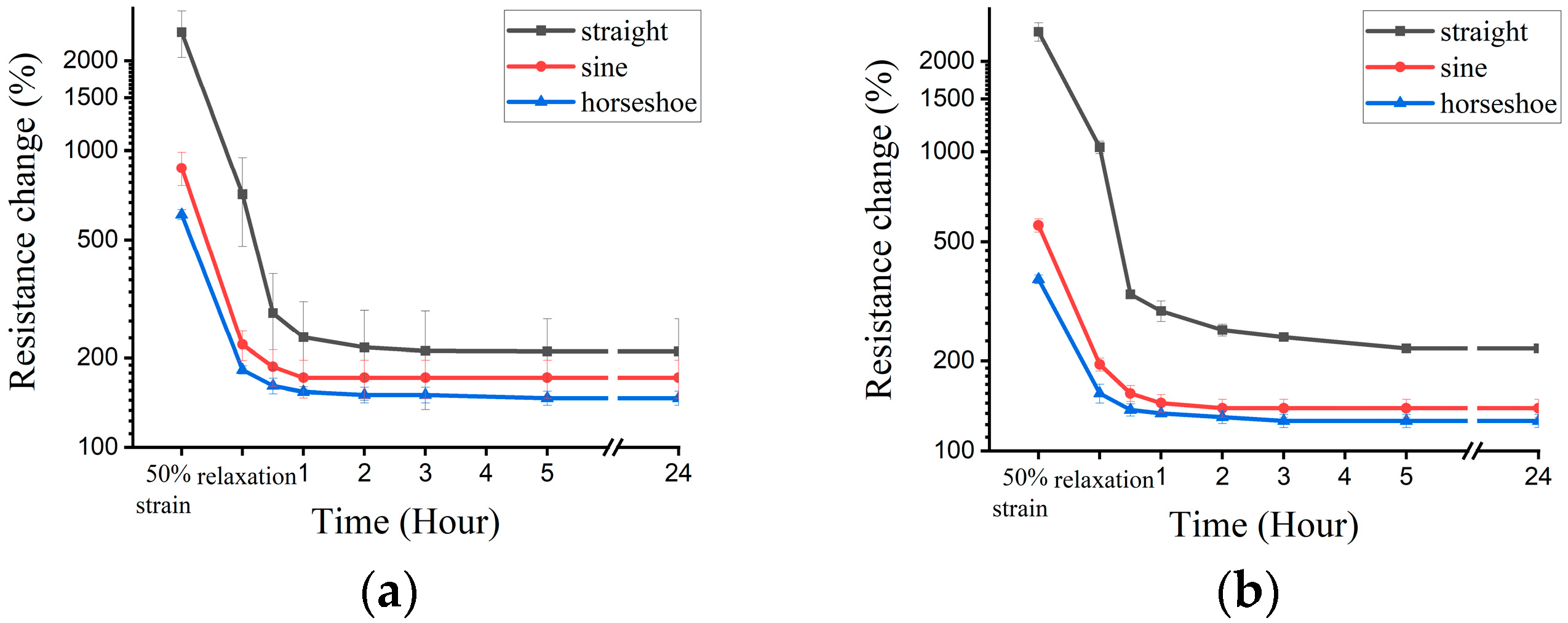Durability Testing of Knitted E-Textiles and Design of a User-Friendly E-Sleeve for Stroke Arm and Hand Rehabilitation †
Abstract
1. Introduction
2. Knitted Fabrics and Tensile Property
2.1. Fabric Structure
2.2. Fabrics Tensile Test
3. Stretchability Test
3.1. Sample Preparation and Test Set-Up
3.2. Result
3.2.1. Length Recovery
3.2.2. Resistance Change
4. E-Sleeve Design and Usability Test
5. Conclusions
Author Contributions
Funding
Institutional Review Board Statement
Informed Consent Statement
Data Availability Statement
Acknowledgments
Conflicts of Interest
References
- Patel, A.; Berdunov, V.; Quayyum, Z.; King, D.; Knapp, M.; Wittenberg, R. Estimated societal costs of stroke in the UK based on a discrete event simulation. Age Ageing 2020, 49, 270–276. [Google Scholar] [CrossRef] [PubMed]
- Stroke Statistics. Available online: https://www.stroke.org.uk/what-is-stroke/stroke-statistics (accessed on 6 September 2023).
- Liu, M.; Ward, T.; Keim, O.; Yin, Y.; Tudor, M.; Yang, K. Smart Textile with Integrated Functional Electrical Stimulation and Movement Sensor for Hand Exercise. In Proceedings of the Annual Conference of the International Functional Electrical Stimulation Society (IFESS): RehabWeek 2022, Rotterdam, The Netherlands, 25–29 July 2022. [Google Scholar] [CrossRef]
- Liu, M.; Ward, T.; Keim, O.; Yin, Y.; Taylor, P.; Tudor, J.; Yang, K. Design and Test of E-Textiles for Stroke Rehabilitation. Eng. Proc. 2023, 30, 16. [Google Scholar] [CrossRef]
- Elastomeric. Available online: https://www.yeoman-yarns.co.uk/product/elastomeric/ (accessed on 15 January 2024).
- Fluid. Available online: https://www.yeoman-yarns.co.uk/product/fluid/ (accessed on 15 January 2024).





| Views | Tubular Jacquard | All Needle Back Jacquard | |
|---|---|---|---|
| Top view | Front bed |  |  |
| Back bed | |||
| 3D view | Front bed |  |  |
| Back bed | |||
| Reverse side view (interface) | Back bed only |  |  |
Disclaimer/Publisher’s Note: The statements, opinions and data contained in all publications are solely those of the individual author(s) and contributor(s) and not of MDPI and/or the editor(s). MDPI and/or the editor(s) disclaim responsibility for any injury to people or property resulting from any ideas, methods, instructions or products referred to in the content. |
© 2024 by the authors. Licensee MDPI, Basel, Switzerland. This article is an open access article distributed under the terms and conditions of the Creative Commons Attribution (CC BY) license (https://creativecommons.org/licenses/by/4.0/).
Share and Cite
Liu, M.; Lake-Thompson, G.; Keim, O.; Brook, P.; Sutcliffe, S.; Tudor, J.; Yang, K. Durability Testing of Knitted E-Textiles and Design of a User-Friendly E-Sleeve for Stroke Arm and Hand Rehabilitation. Eng. Proc. 2023, 52, 18. https://doi.org/10.3390/engproc2023052018
Liu M, Lake-Thompson G, Keim O, Brook P, Sutcliffe S, Tudor J, Yang K. Durability Testing of Knitted E-Textiles and Design of a User-Friendly E-Sleeve for Stroke Arm and Hand Rehabilitation. Engineering Proceedings. 2023; 52(1):18. https://doi.org/10.3390/engproc2023052018
Chicago/Turabian StyleLiu, Meijing, Gillian Lake-Thompson, Odina Keim, Paul Brook, Steve Sutcliffe, John Tudor, and Kai Yang. 2023. "Durability Testing of Knitted E-Textiles and Design of a User-Friendly E-Sleeve for Stroke Arm and Hand Rehabilitation" Engineering Proceedings 52, no. 1: 18. https://doi.org/10.3390/engproc2023052018
APA StyleLiu, M., Lake-Thompson, G., Keim, O., Brook, P., Sutcliffe, S., Tudor, J., & Yang, K. (2023). Durability Testing of Knitted E-Textiles and Design of a User-Friendly E-Sleeve for Stroke Arm and Hand Rehabilitation. Engineering Proceedings, 52(1), 18. https://doi.org/10.3390/engproc2023052018








